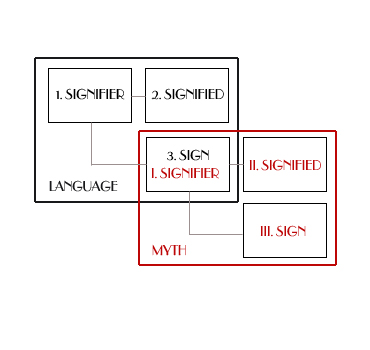| Roland Barthes | Myth Today (1957) | |
|
|
||
| Mith as a second order semiological system | ||
|
In mith we find again the three-dimensional pattern: the signifier, the signified and the sign. But mith is a peculiar system, in that it is a constructed from a semiological chainwhich existed before it: it is a second order semiological system. That which is a sign (the associative total of a concept and an image) in the first system, becomes a mere signifier in the second. The material of mythical speech, however different at the start, are reduced to a pure signifying function as soon as they are caught by myth. Whatever it deals only with alphabetical or pictorial writing, myth wants to see in them only a sum of signs, a global sign, the final term of a first semiological chain. And it is precisely this final term which will become the first term of a greater system This lateral shift is essential for the analysis of mith.
In myth there are two semiological systems, one of which is staggered in relation to the other: a linguistic system, the language, which Barthes calls language-object, because it is the language which myth gets hold of in order to build its own system; and myth itself, which Barthes calls metalanguage, because it is a second language in which one speacks about the first. When he reflects on a metalanguage, the semiologist no longer needs to ask himself questions about the composition of the language-object, he no longer has to take into account the details of the linguistic schema; he will only need to know its total term, or global sign, and only as this term lends itself to mith. The is why the semiologist is entitled to treat in the same way writing and pictures: what he retains from them is the fact that they are both signs and they constitute a language-object.
|
||
